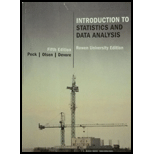
Concept explainers
An experiment to determine if an online intervention can reduce references to sex and substance abuse on social networking web sites of adolescents is described in the paper “Reducing At-Risk Adolescents’ Display of Risk Behavior on a Social Networking Web Site” (Archives of Pediatrics and Adolescent Medicine [2009]: 35–41). Researchers selected public MySpace profiles of people who described themselves as between 18 and 20 years old and who referenced sex or substance use (alcohol or drugs) in their profiles. The selected subjects were assigned at random to an intervention group or a control group.
Those in the intervention group were sent an e-mail from a physician about the risks associated with having a public profile and of referencing sex or substance use in their profile. Three months later, networking sites were revisited to see if any changes had been made. The following excerpt is from the paper:
At baseline, 54.2% of subjects referenced sex and 85.3% referenced substance use on their social networking site profiles. The proportion of profiles in which references decreased to O was 13.7% in the intervention group vs. 5.3o/o in the control group for sex (P =.05) and 26% vs. 22% for substance use (P =.61). The proportion of profiles set to “private” at follow-up was 10.5% in the intervention group and 7.4% in the control group (P = .45). The proportion of profiles in which any of these three protective changes were made was 42.1 % in the intervention group and 29.5% in the control group (P = .07).
- a. The quote from the paper references four hypothesis tests. For each test, indicate what hypotheses you think were tested and whether or not the null hypothesis was rejected.
- b. Based on the information provided by the hypothesis tests, what conclusions can be drawn about the effectiveness of the e-mail intervention?
Want to see the full answer?
Check out a sample textbook solution
Chapter 11 Solutions
Introduction to Statistics and Data Analysis
- 9. The concentration function of a random variable X is defined as Qx(h) = sup P(x ≤ X ≤x+h), h>0. Show that, if X and Y are independent random variables, then Qx+y (h) min{Qx(h). Qr (h)).arrow_forward10. Prove that, if (t)=1+0(12) as asf->> O is a characteristic function, then p = 1.arrow_forward9. The concentration function of a random variable X is defined as Qx(h) sup P(x ≤x≤x+h), h>0. (b) Is it true that Qx(ah) =aQx (h)?arrow_forward
- 3. Let X1, X2,..., X, be independent, Exp(1)-distributed random variables, and set V₁₁ = max Xk and W₁ = X₁+x+x+ Isk≤narrow_forward7. Consider the function (t)=(1+|t|)e, ER. (a) Prove that is a characteristic function. (b) Prove that the corresponding distribution is absolutely continuous. (c) Prove, departing from itself, that the distribution has finite mean and variance. (d) Prove, without computation, that the mean equals 0. (e) Compute the density.arrow_forward1. Show, by using characteristic, or moment generating functions, that if fx(x) = ½ex, -∞0 < x < ∞, then XY₁ - Y2, where Y₁ and Y2 are independent, exponentially distributed random variables.arrow_forward
- 1. Show, by using characteristic, or moment generating functions, that if 1 fx(x): x) = ½exarrow_forward1990) 02-02 50% mesob berceus +7 What's the probability of getting more than 1 head on 10 flips of a fair coin?arrow_forward9. The concentration function of a random variable X is defined as Qx(h) sup P(x≤x≤x+h), h>0. = x (a) Show that Qx+b(h) = Qx(h).arrow_forward
- Suppose that you buy a lottery ticket, and you have to pick six numbers from 1 through 50 (repetitions allowed). Which combination is more likely to win: 13, 48, 17, 22, 6, 39 or 1, 2, 3, 4, 5, 6? barrow_forward2 Make a histogram from this data set of test scores: 72, 79, 81, 80, 63, 62, 89, 99, 50, 78, 87, 97, 55, 69, 97, 87, 88, 99, 76, 78, 65, 77, 88, 90, and 81. Would a pie chart be appropriate for this data? ganizing Quantitative Data: Charts and Graphs 45arrow_forward10 Meteorologists use computer models to predict when and where a hurricane will hit shore. Suppose they predict that hurricane Stat has a 20 percent chance of hitting the East Coast. a. On what info are the meteorologists basing this prediction? b. Why is this prediction harder to make than your chance of getting a head on your next coin toss? U anoiaarrow_forward
 Glencoe Algebra 1, Student Edition, 9780079039897...AlgebraISBN:9780079039897Author:CarterPublisher:McGraw Hill
Glencoe Algebra 1, Student Edition, 9780079039897...AlgebraISBN:9780079039897Author:CarterPublisher:McGraw Hill College Algebra (MindTap Course List)AlgebraISBN:9781305652231Author:R. David Gustafson, Jeff HughesPublisher:Cengage Learning
College Algebra (MindTap Course List)AlgebraISBN:9781305652231Author:R. David Gustafson, Jeff HughesPublisher:Cengage Learning Big Ideas Math A Bridge To Success Algebra 1: Stu...AlgebraISBN:9781680331141Author:HOUGHTON MIFFLIN HARCOURTPublisher:Houghton Mifflin Harcourt
Big Ideas Math A Bridge To Success Algebra 1: Stu...AlgebraISBN:9781680331141Author:HOUGHTON MIFFLIN HARCOURTPublisher:Houghton Mifflin Harcourt



